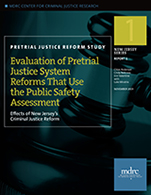Evaluation of Pretrial Justice System Reforms That Use the Public Safety Assessment
Effects of New Jersey’s Criminal Justice Reform

 On January 1, 2017, the State of New Jersey implemented Criminal Justice Reform (CJR), a sweeping set of changes to its pretrial justice system. With CJR, the state shifted from a system that relied heavily on monetary bail to a system based on defendants’ risks of failing to appear for court dates and of being charged with new crimes before their cases were resolved. These risks are assessed using the Public Safety Assessment (PSA), a pretrial risk-assessment tool developed by Arnold Ventures with a team of experts. The PSA uses nine factors from an individual’s criminal history to produce two risk scores: one representing the likelihood of a new crime being committed, and another representing the likelihood of a failure to appear for future court hearings. The PSA also notes whether there is an elevated risk of a violent crime. The PSA is used in conjunction with a New Jersey-specific decision-making framework (DMF) that uses an individual’s PSA risk score in combination with state statutes and statewide policies to produce a recommendation for release conditions.
On January 1, 2017, the State of New Jersey implemented Criminal Justice Reform (CJR), a sweeping set of changes to its pretrial justice system. With CJR, the state shifted from a system that relied heavily on monetary bail to a system based on defendants’ risks of failing to appear for court dates and of being charged with new crimes before their cases were resolved. These risks are assessed using the Public Safety Assessment (PSA), a pretrial risk-assessment tool developed by Arnold Ventures with a team of experts. The PSA uses nine factors from an individual’s criminal history to produce two risk scores: one representing the likelihood of a new crime being committed, and another representing the likelihood of a failure to appear for future court hearings. The PSA also notes whether there is an elevated risk of a violent crime. The PSA is used in conjunction with a New Jersey-specific decision-making framework (DMF) that uses an individual’s PSA risk score in combination with state statutes and statewide policies to produce a recommendation for release conditions.
The PSA is used at two points in New Jersey’s pretrial process: (1) at the time of arrest, when a police officer must decide whether to seek a complaint-warrant (which will mean booking the person into jail) or issue a complaint-summons (in which case the defendant is given a date to appear in court and released); and (2) at the time of the first court appearance, when judges set release conditions for defendants who were booked into jail on complaint-warrants. (The DMF is also used at this second point.) CJR includes a number of other important components: It all but eliminated the use of monetary bail as a release condition, established the possibility of pretrial detention without bail, established a pretrial monitoring program, and instituted speedy-trial laws that impose time limits for case processing.
This report is one of a planned series on the impacts of New Jersey’s CJR. It describes the effects of the reforms on short-term outcomes, including the number of arrest events (where an “arrest event” is defined as all complaints and charges associated with a person on a given arrest date), complaint charging decisions, release conditions, and initial jail bookings. Additional reports in this series will examine CJR’s effects on outcomes such as court appearance rates, new arrests, the amount of time defendants are in jail while waiting for their cases to be resolved, and case dispositions (that is, whether defendants were found guilty or not guilty or had their cases dismissed). The effects of the reforms for different subgroups of the pretrial population (for example, those defined by risk levels and race) will also be examined in a subsequent report.
Findings in this report include:
- Fewer arrest events took place following CJR’s implementation. There was a reduction in the number of arrest events for the least serious types of charges — namely, nonindictable (misdemeanor) public-order offenses.
- Police officers appear to be issuing complaint-summonses more often and seeking complaint-warrants less often since CJR was implemented.
- Pretrial release conditions imposed on defendants changed dramatically as a result of CJR. A larger proportion of defendants were released without conditions, and rates of initial booking into jail were lower than predicted given pre-CJR trends.
- CJR significantly reduced the length of time defendants spend in jail in the month following arrest.
- CJR had the largest effects on jail bookings in counties that had the highest rates of jail bookings before CJR.







